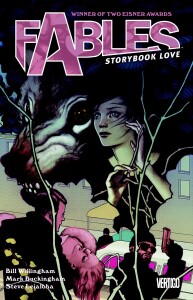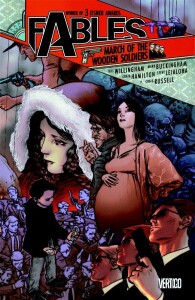 Storybook Love: Bill Willingham writer; Mark Buckingham, Steve Leialoha artists
Storybook Love: Bill Willingham writer; Mark Buckingham, Steve Leialoha artists
March of the Wooden Soldiers: Bill Willingham writer; Mark Buckingham, Craig Hamilton, Steve Leialoha, P. Craig Russell artists
The Mean Seasons: Bill Willingham writer; Tony Akins, Mark Buckingham, Steve Leialoha, Jimmy Palmiotti artists
These three volumes continue Bill Willingham’s fascinating tale of fairy tale denizens exiled to our own world, a story he began spinning with Legends in Exile and Animal Farm. Spanning issues 11-33 (albeit slightly out of order), these volumes provide further character development and some intriguing plot advancement, as The Adversary extends his reach far and wide to destroy those who escaped him.
Storybook Love is a collection of shorts, which, for the most part, aren’t about love at all, but more about ambition, deceit and treachery. In the opening story “Bag o’ Bones” we find trickster Jack up to no good back in the days of the Civil War. Having thrown in with the losing side (but rich on poker winnings) and worn out his welcome, Jack treks back north to Fabletown. Along the way he cheats the Devil out of a magic bag that can hold anything, which Jack then puts to nefarious use, confining Death so that Jack may bed the lovely southern belle he finds on her death bed. Only … with the Grim Reaper at bay, no one can die.
“A Sharp Operation: Part One of a Two-Part Caper” and “A Dirty Business: Part Two of a Two-Part Caper” pit Bigby Wolf against a tabloid reporter intent on telling the world that the residents of Fabletown are vampires. Unbeknownst to Snow White and King Cole, and against Bluebeard’s wishes (to just kill the man) Bigby devises an elaborate operation to destroy all the reporter’s evidence of Fabletown — an operation involving Bluebeard, Jack, Flycatcher (the frog prince), Prince Charming and the ever-cursed Briar Rose (Sleeping Beauty). However, when they realize the reporter has stashed backups of all his files across the internet, it’s sly Jack who devises a far more modern, and fitting, means of silencing the man.
The title story and the volume’s longest is comprised of three chapters: “The Mouse Police Never Sleep,” “Into the Woods,” and “Duel.” This story finds fugitive Goldilocks in bed with Bluebeard, both literally and figuratively. Seeking revenge for past slights, the pair conspire to assassinate Snow White and Bigby. The plot, of course, fails, with Goldilocks falling prey to her would-be victims, and Bluebeard to someone else entirely unexpected. We find out something very significant about Bigby’s parentage (ever wondered how the heck the Big Bad Wolf could blow down a house of bricks? Wonder no longer!), and get to see him in wolf form for the first time. And just what did happen between Snow White and Bigby while under the influence of Bluebeard’s spell?
“Barleycorn Bride” closes the volume, in affable look back at the history of the Lilliputians in Fabletown, as told by Bigby to Flycatcher to explain why it’s a Lilliputian rite of passage to sneak down from the Farm to Fabletown for the purpose of stealing a magical piece of barleycorn from a jar stored there.
 March of the Wooden Soldiers provides both a tantalizing look back at the Fables’ last stand against The Adversary, and a ringside view of an impassioned stand in the here and now of Fabletown against an army of his wooden soldiers.
March of the Wooden Soldiers provides both a tantalizing look back at the Fables’ last stand against The Adversary, and a ringside view of an impassioned stand in the here and now of Fabletown against an army of his wooden soldiers.
In the flashback “The Last Castle,” Blue (as in Little Boy Blue) tells Flycatcher about the last big battle, held at the Fables’ remaining stronghold, with the remaining Fables holding out until they could get a last boatful of their companions safely to the mundane world. Blue had been an Aide de Camp for Colonel Bearskin at the end … and it’s just before that battle that he met and fell in love with Little Red Riding Hood. Only to lose her when he escapes on the last boat and she gives up her berth to stay behind, not realizing his escape was assured from the outset. It’s a poignant, heartbreaking story on many levels, as we hear about the fall of Sir Pellinore, Britomartis, and Tam Lin, among other heroes. And we discover that Prince Charming and Cinderella were two of the last Fables to escape. No one is more surprised then Blue when Red, or at least someone who looks very much like Red, arrives in Fabletown claiming to have survived the battle and years of imprisonment at the hands of The Adversary.
After centuries with no new Fable escapees, Fabletown is captivated by Red. Everyone except for Bigby, that is, who is naturally suspicious, and does some investigating on his own, far afield. In the meantime, Red shows her true colours — to a few, at least — when Fabletown soon finds itself under siege by an army of black-suited, sunglasses-wearing wooden men who look a lot like Pinocchio, only grown up. Fables from the city and Farm alike join together to defend their home from this deadly assault — and keep the battle from prying mundy eyes. They succeed, but only with much sacrifice. Afterwards, behind the scenes, we are treated to a bit of Bigby’s darker side, vital to Fabletown’s survival but toe-curling nonetheless.
Getting less screen time than the main plot line revolving around Red, but perhaps more significant for Fabletown in the short-term are two subplots: one involving Prince Charming running for mayor of Fabletown (not for altruistic reasons, of course) and the other concerning a now obviously pregnant Snow White (so that’s what happened!). The volume closes with Fabletown slowly returning to normalcy and … Snow’s water breaking.
 The Mean Seasons is another collection of shorts, the last of which continues the plot from volume four.
The Mean Seasons is another collection of shorts, the last of which continues the plot from volume four.
First we are treated to a glimpse of the real Cinderella in the standalone story “Cinderella Libertine.” She may seem like she’s merely a shoe shop owner and the shallowest and grumpiest of Prince Charming’s ex-wives (Cinderella was his third, after Snow White and Briar Rose), but there’s much more to this beauty than meets the eye.
Second is a two-part tale (“War Stories” ) about Bigby and a group of American soldiers he leads behind Nazi lines during World War II. It’s a fascinating snapshot of Bigby from the point of view of an outsider, a human, one of a handful to see Bigby’s true form.
The volume’s final story, from which it draws its title, weaves together the two subplots mentioned in the write-up of Volume 4: Charming’s ambition to rule Fabletown and Snow White’s pregnancy. Prince Charming gets his wish — and access to Bluebeard’s coffers — but it proves to be far more work to govern than he anticipated. Beauty and Beast, stepping into Snow and Bigby’s roles respectively, discover much the same. Meanwhile, Snow has retreated to the Farm after the birth of her litter (yes, litter) of not quite human children, resulting in Bigby (banned for eternity from the Farm because of the, well, Three Pigs incident) sulking away from both Fabletown and his children. At the Farm, Snow meets Bigby’s larger-than-life father, come to New York to meet his grandchildren.
Book five closes with Fabletown in mild disarray, and missing a few denizens, but with Snow White and Rose Red seemingly reconciled, and intent on the safety and well-being of Snow’s children.
Willingham continues to produce witty, sharp dialog and compelling characters as he guides the story ever closer to an inevitable clash with The Adversary. It’s very handy that as the cast of characters grows, each volume includes pages at the beginning with pictures and brief bios of the key players. And while the art varies from story to story, in both style and quality, it remains consistently serviceable for the story. I can offer no higher praise than to say that the instant I finished The Mean Seasons, I went online looking for volume six, Homelands, to devour, which was not available for another six months or so (much to my dismay).
(Vertigo, 2004)
(Vertigo, 2004)
(Vertigo, 2005)
Publishers Weekly has a Bill Willingham author page.
